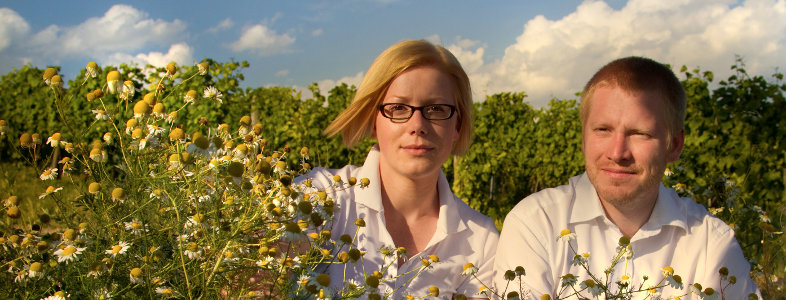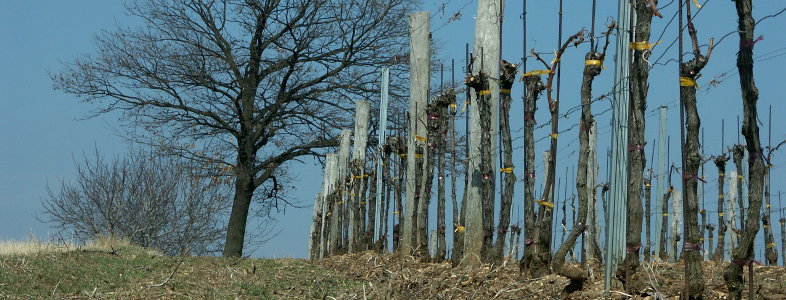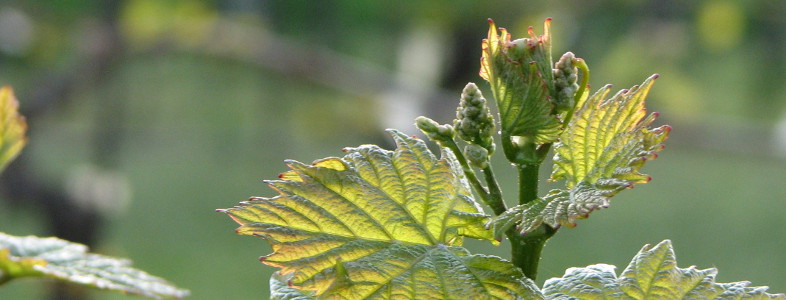








 The last way in the life of a vineyard, the clearing. Well-tended vineyards can last for 30 to 50 years.
But the older they get, the more care they need. Yields drop and more and more vines have to be
replanted. In the course of decades, grape varieties also change and even cultivation methods are
subject to constant modernisation. At some point it is time to grub up and replant.
Read more »
The last way in the life of a vineyard, the clearing. Well-tended vineyards can last for 30 to 50 years.
But the older they get, the more care they need. Yields drop and more and more vines have to be
replanted. In the course of decades, grape varieties also change and even cultivation methods are
subject to constant modernisation. At some point it is time to grub up and replant.
Read more »
 Time flies and all work comes to an end. It’s like we just started, but the harvest is already done and
with it the 2019 wine year lies behind us. Now we can for the first time really make some substantial
statements about the vintage’s qualities. In short, we’re very pleased!
Read more »
Time flies and all work comes to an end. It’s like we just started, but the harvest is already done and
with it the 2019 wine year lies behind us. Now we can for the first time really make some substantial
statements about the vintage’s qualities. In short, we’re very pleased!
Read more »
 The proper wine harvest will start immediately after the Dornbirn Autumn fair in mid September. But
we're already picking some grapes right now. They are just not destined for winemaking, rather they are
table grapes meant for eating. Even more special is that they are new, fungus-resistant varieties that
practically require no spraying - not even with organic formulations. This saves us a lot of time and
labour while the grapes are still crisp and beautiful to look at.
Read more »
The proper wine harvest will start immediately after the Dornbirn Autumn fair in mid September. But
we're already picking some grapes right now. They are just not destined for winemaking, rather they are
table grapes meant for eating. Even more special is that they are new, fungus-resistant varieties that
practically require no spraying - not even with organic formulations. This saves us a lot of time and
labour while the grapes are still crisp and beautiful to look at.
Read more »
 Yield management is a key factor in making great wines. The most important decisions are already made
during winter pruning. But now, with the harvest in sight, it is time for some fine-tuning. Depending on
the grape variety, there is more or less to do. But thinning the yield to a level that will help us
harvest grapes with the ripeness we need, is what really counts.
Read more »
Yield management is a key factor in making great wines. The most important decisions are already made
during winter pruning. But now, with the harvest in sight, it is time for some fine-tuning. Depending on
the grape variety, there is more or less to do. But thinning the yield to a level that will help us
harvest grapes with the ripeness we need, is what really counts.
Read more »
 A lot has to change if we want to avert the oncoming climate crisis and continue to make a living from
creating fine wines here in Gols. Wine production naturally needs power too - fuel as well as
electricity. And as every organic farm should, we’re thinking a lot about how to make things less
harmful for our planet.
Read more »
A lot has to change if we want to avert the oncoming climate crisis and continue to make a living from
creating fine wines here in Gols. Wine production naturally needs power too - fuel as well as
electricity. And as every organic farm should, we’re thinking a lot about how to make things less
harmful for our planet.
Read more »
 Like every year the first grapes to bloom are from the St. Laurent variety. The picture shows its very
first blossoms. Altough not too much to look at, a fully abloom vineyard offers an impressive fragrant
smell.
Read more »
Like every year the first grapes to bloom are from the St. Laurent variety. The picture shows its very
first blossoms. Altough not too much to look at, a fully abloom vineyard offers an impressive fragrant
smell.
Read more »
 In spring organic vineyards can be spottet from a long distance. The green manure plants are in full
bloom, long before our vines develop their own flowers. Green manure offers food and habitat for small
insects and bigger animals alike. Even hare or deer youngs like to hide between the growing greens. Our
vineyards are therefore not only an important contribution to biodiversity, the green manure also
provides essential nutrition for our vines, without the need for any synthetic fertilizers. But
honestly, the beautiful sight is reason enough to enjoy the view this time of the season.
Read more »
In spring organic vineyards can be spottet from a long distance. The green manure plants are in full
bloom, long before our vines develop their own flowers. Green manure offers food and habitat for small
insects and bigger animals alike. Even hare or deer youngs like to hide between the growing greens. Our
vineyards are therefore not only an important contribution to biodiversity, the green manure also
provides essential nutrition for our vines, without the need for any synthetic fertilizers. But
honestly, the beautiful sight is reason enough to enjoy the view this time of the season.
Read more »
 We cover the lower parts of our grapevines with soil before winter sets in to protect them from
exceedingly deep frost events. Now in the spring, they are uncovered using a plough so that they can
enjoy a bit of warm and fresh air. This also fights the weeds next to our vines while the greenery
between the rows is left to bloom. The picture nicely shows the outcome, before and after ploughing.
Read more »
We cover the lower parts of our grapevines with soil before winter sets in to protect them from
exceedingly deep frost events. Now in the spring, they are uncovered using a plough so that they can
enjoy a bit of warm and fresh air. This also fights the weeds next to our vines while the greenery
between the rows is left to bloom. The picture nicely shows the outcome, before and after ploughing.
Read more »
Spring is almost here and our vines are slowly awaking. They have not yet started to grow but if the current warm conditions last, it is only a matter of a short while. Actually we hope for some cooler days to slow down the vine's development tough. A later start into the season means less danger from late frost. We'll see, maybe everything turns out like 2018 again, a year that was ideal in all respects. We wait in suspense! Read more »
Following the Holiday season it is not too busy out in our vineyards. While this is the time for winter pruning, we do not have to finish it until spring comes around. So now we have the best chance to present our wines directly to as many of our customers as possible. Read more »